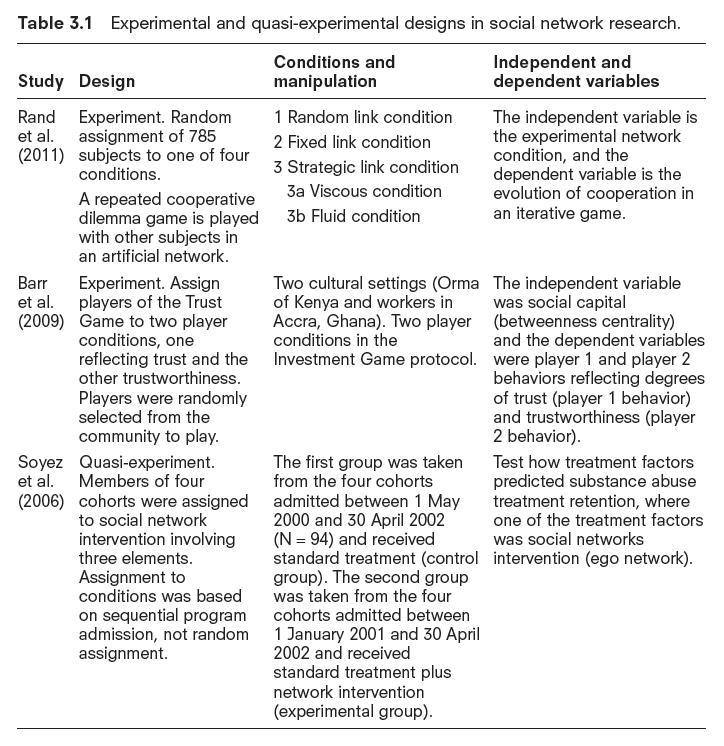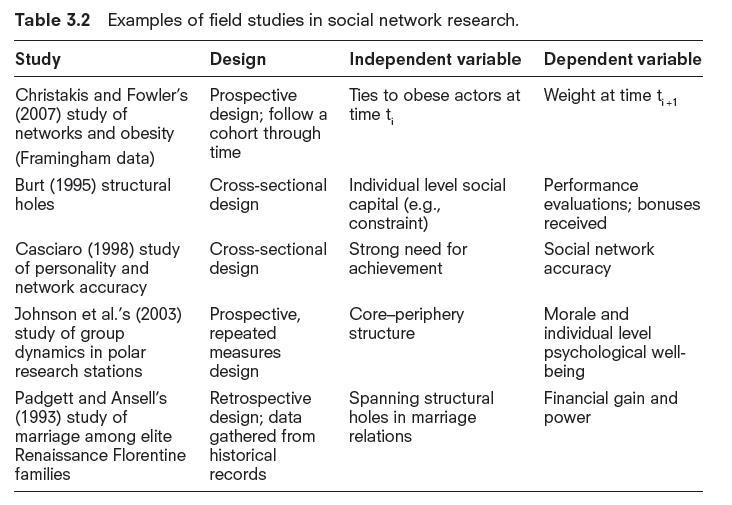Chapter 3: Research Design
3.11 Problems and Exercises
1. For each of the research problems in Chapter 1, Problem 1, what are the independent and dependent variables? Based on the designs outlined in Tables 3.1 and 3.2, what type of research design does each of the research problems suggest?
a. In a coeducational summer camp for teens, researchers want to know the extent to which attitudes about religion play a role in the formation of friendships within the first week of coming to camp.
Answer: Independent variable is attitudes towards religion and the dependent variable is friendship tie formation. Design: field study
b. An anthropologist is interested in studying the relationship between Canadian Inuit hunters’ structural position in a hunting advice network, as measured by indegree centrality, and their hunting success.
Answer: Independent variable is centrality in a hunting advice network and the dependent variable is hunting success. Design: field study
c. A sports psychologist is interested in studying the relationship between basketball team cohesion off the court and number of regular season wins among a sample of 30 US universities.
Answer: Independent variable is basketball team cohesion and the dependent variable is regular season wins. Design: field study
d. A political scientist hypothesizes a relationship between the presence of international trade relations and the formation of bilateral defense agreements.
Answer: Independent variable is international trade relations and the dependent variable the formation of bilateral defense agreements. Design: field study
e. An agricultural extension researcher proposes that time of adoption of a new fertilizer among Iowa corn farmers is related to the structural centrality of farmers in a communication network.
Answer: Independent variable is the structural centrality of farmers in a communication network and the dependent variable is the time of adoption of a new fertilizer among Iowa corn farmers. Design: field study
f. An organizational sociologist hypothesizes that the more regional sales teams have a centralized information-sharing network the greater the team’s overall sales.
Answer: Independent variable is the degree of centralized information-sharing networks in regional sales teams and the dependent variable is the team’s overall sales. Design: field study
g. An educational researcher is interested in how the political views of incoming freshmen at a large university affect the formation of friendship ties over the first semester.
Answer: Independent variable is the political views of incoming freshmen and the dependent variable the formation of friendship ties over the first semester. Design: field study
h. A network researcher is interested in the relationship between astronaut knowledge of mission network structure and psychological well-being over the course of a 30-day simulated mission.
Answer: Independent variable is astronaut knowledge of mission network structure and the dependent variable is psychological well-being over the course of a 30-day simulated mission. Design: field study
i. A management researcher advocates that highly centralized networks are more efficient at a variety of task settings than distributed networks, and designs an experiment to test this hypothesis.
Answer: Independent variable is the extent to which a network is centralized and the dependent variable is efficiency in various task settings. Design: field study
2. For each of the research questions below, discuss whether a whole or personal network approach is more appropriate. NOTE: Although either whole or personal networks can be used in any of the hypothetical research efforts, the answer provided suggests the most efficient approach for each.
a. How do social relations in a university sports club influence members’ attitudes towards university sports policies?
b. To what extent is smoking behavior among adolescents affected by their social networks?
Answer: Could be either but personal networks may be more appropriate
c. How much do voting patterns in a state legislature conform to political party affiliation?
d. How do immigrants’ social networks affect cultural assimilation?
Answer: Personal networks
e. Does the network structural position of a manger in a financial firm impact that manager’s performance?
f. To what extent is toothpaste brand selection affected by consumers’ social networks?
Answer: Personal Networks
g. To what extent is the social network structure at a commercial fish camp in Canada influenced by ethnicity?
h. What factors influence the development of cooperative social relations among activists in an environmental social movement?
3. Produce a hypothetical social network study example for each of the three major types of research designs: experimental, quasi-experimental and observational. For each example, identify the independent and dependent variables.
Answer: These will depend on the hypothetical studies produced. See Tables 3.1 and 3.2
4. For the hypothetical observational design presented in problem 3 above, is the design cross-sectional, retrospective, or prospective? What are the advantages and disadvantages of each in the study of social networks?
Answer: See Tables 3.1 and 3.2


5. Bounding the network in whole social network studies can be challenging and is important in designing valid research. For each of the social network examples below, provide a discussion for how the networks might be bounded in the design of a whole network study.
(NOTE: These are just one of many possible responses to the examples).
a. A study of fraternities at a medium-sized Midwestern university
Answer: A researcher could select a large fraternity and bound the network by its membership
b. The study of an informal gay group in an urban neighborhood
Answer: Depending on the size of the group, all members could be studied based on group member’s determination of membership. This could involve a free-listing of member’s names and bounding the network by the most frequently mentioned names
c. The network relations among active hunters in a small village in the Amazon
Answer: The names of the most active hunters could be elicited from village members and then bounded by degree of activity (e.g., only the most active hunters)
d. Relationships among NGOs involving a dam project in West Africa
Answer: Elicit a list of NGOs working in the area through interviews with known NGO employees. The list can help in bounding the network
e. Food-sharing networks in a village in Central Asia
Answer: Since the village is the focus, depending on the size of the village all households could be included in the network
f. The political network of community activists in a moderate sized city
Answer: Elicit from known community activists ‘other politically active people they know of in the city.’ This list can then be used to determine who is in or out of the whole network study
6. Nonresponse in social network surveys can be a major threat to the validity of a social network study. What are some of the ways researchers can minimize survey nonresponse?
There are many ways to reduce non-response but the following are key:
-
Build rapport with the people in the study in order to gain their trust
-
Try not to over burden the respondents with questionnaires that are too long and mentally taxing. This is particularly important if the study involves multiple data collection points
-
Do preliminary work to make sure the network questions are relevant and clear. Working with people in the study to develop good and valid questions is always useful
7. What are some of the key ethical concerns in social network research as opposed to other types of more traditional research, such as classical social surveys?
The primary issue is one of anonymity. Where in surveys both confidentiality and anonymity can be achieved, anonymity is more problematic in social network studies. As the chapter notes:
‘Network research poses different ethical challenges from those of other kinds of social research, particularly in whole-network research designs. In whole network designs, it is impossible to collect the data anonymously. Personal-network research designs can be anonymous, both with respect to the respondent and the people they mention (e.g., they can use nicknames). But for all practical purposes, full network designs require that the respondent identify themselves, which means the researcher can only offer confidentiality. This makes it imperative that the researcher make it clear to the respondent who will see the raw data what can reasonably be predicted to happen to the respondent as a result of an accidental breach of confidentiality.’ (p. 46)


